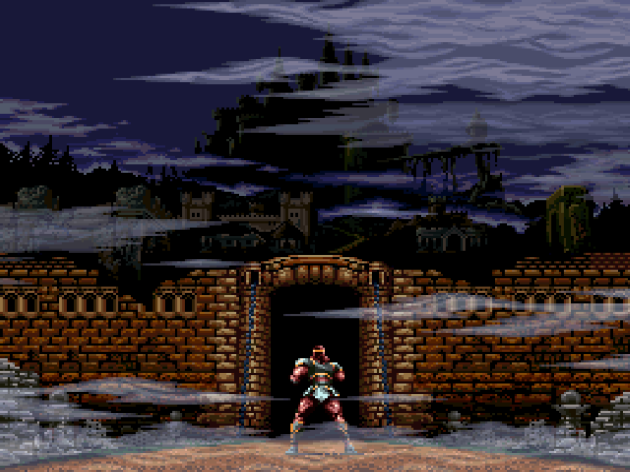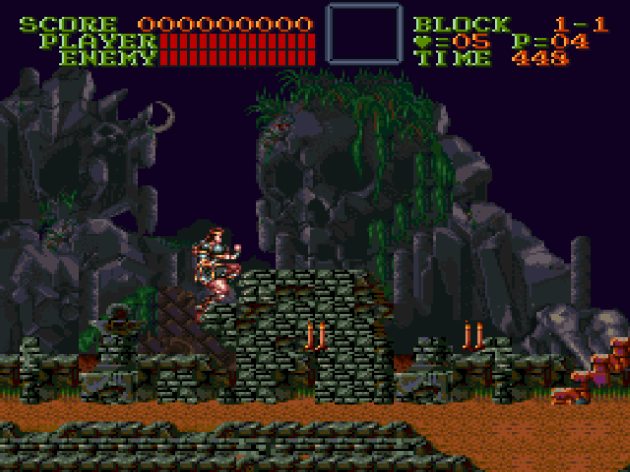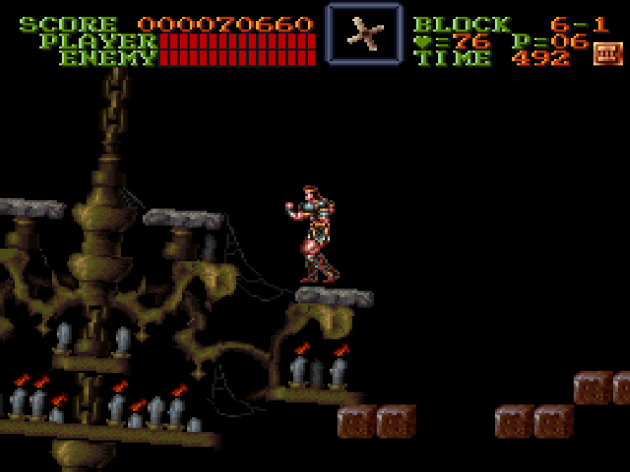Super Castlevania IV (SNES Review)
October 29, 2023 1 Comment
 Super Castlevania IV
Super Castlevania IV
aka Akumajō Dracula
Platform: Super Nintendo Entertainment System
Developed by Konami
First Released October 31, 1991
Included in Castlevania Anniversary Collection

“Alright, I’ll knock this f*cking thing down.. AGAIN.. but YOU peasants have to build a strip mall on the foundation when I finish! Next time Dracula comes back, he’ll have to deal with a Kinko’s in his courtyard!” “HAH, JOKE’S ON YOU, SIMON! KINKO’S NO LONGER EXISTS! IT’S FED-EX OFFICE NOW!” “Fed-Ex? Shit.. that’s pretty evil. YOU WIN THIS ROUND, DRACULA!”
Maybe it’s just me, but when I play Super Castlevania IV, I never can shake the “this is just a glorified tech demo” feeling. This was made by an entirely different team from the developers responsible for the NES series, and you can tell. Castlevania IV’s team was apparently chosen specifically to squeeze the most potential out of the brand new Super NES. Frankly, it’s a miracle it’s as good as it is. I actually played it before I played Castlevania III: Dracula’s Curse, and once I had played both, I originally held Super Castlevania IV in higher esteem. These days, it’s no contest: Dracula’s Curse is the one and only linear Castlevania that can stake a claim as the best Castlevania game, even when compared to the Metroidvanias. Meanwhile, Super Castlevania IV’s tech demo nature stands out more and more every time I play it. That, and it’s kind of easy, and Castlevania games should NEVER be easy.

Given that Konami did the Goonies games, it’s entirely possible Mikey is fighting the Blues Brothers a few miles to the left of Simon here.
Why’s it so easy? Well, I have a theory, and I might as well get that out of the way first. Okay, here’s my bonkers conspiracy theory: I think Super Castlevania IV didn’t originally have eight-way whipping until after they finished the level layouts and enemy placement. I’ve scoured the interwebs looking for verification on this, and the only details I could find is that they wanted the whip to do things on the Super NES it couldn’t do on the NES. Eight-way whipping, and presumably the whip-flicking, was originally something the development team wanted for Castlevania 1, but the NES couldn’t handle it. In an interview with Retro Gamer, director Masahiro Ueno notes that development started while Castlevania III was still being worked on, and that frequent tinkering and reworking was done. That really ought to shoot down my theory, since they could fix any issues eight-way would cause. However, if you look at the enemy placement, it sure seems like it’s optimized specifically for the old way. The “you can only whip straight ahead of you” way. From the placement of staircases to the distance between you and the enemies, it feels like the nerfy “any direction” method was something that was added with very little consideration for the difficulty.

And you thought the sub-weapons nerfed the game before. Here, I’m literally draping a motionless chain over an enemy and defeating it. It would be like being able to stop the forces of evil from entering your house by hanging a dog’s leash over the door.
Now, while I’m sure philosophers will tell you the most heroic thing a hero can do is avoid confrontation, this is a video game, and the first 16-bit entry in a franchise renowned for its high difficulty. If not for the ghosts and undead minions, Castlevania IV would be almost kiddie. It’s not as if you can only avoid directly facing enemies once in a while. It happens constantly, and it’s even worse because of the introduction of the wrist-flick. With it, needing to expertly time whipping the projectiles enemies spit out is gone. Just hold the magic whip out and it acts as a shield. Weaker enemies don’t require you to crack them with precision. Just hold out the magic whip and let them fly into it. If an enemy is below you, just drape the magic whip over them from a higher platform. It does less damage, so it’ll take longer than normal attacks, but they’ll die just the same. It’s one of those “sounds good on paper, not as good in practice” situations, and I think it and the eight-way was a last-second addition. My ultimate proof: every single boss seems to have been based around being able to attack them straight-ahead, not from an angle. There’s even platforms tailored around it and their weak points. I think I’m onto something.
I have no issue with the concept of Simon being able to attack in all directions. In fact, I rather like it. It feels great, too! It’s very intuitive and easy to get the hang of. But, you need to build the game around it, and Castlevania IV rarely feels like the levels were optimized for the eight-way attacks. Especially the vertical usage. By that, I mean where it feels like they specifically created a situation where you’re reacting to something above you. In fact, after a stretch in the first level, it almost never happens. If you’re going to include eight directions to attack, you need to incentivize it by including eight directions of immediate danger. They didn’t do that nearly enough. The eight-way whip is mostly useful as a preemptive assault against enemies who currently pose no direct threat to you. And, thanks to your limitless 8-way attack, they never will.

This is the section I’m talking about. These enemies drop on you from above. There’s not a lot of this in the game.
This creates what I call the CV4 Paradox. The CV4 Paradox states that, if your basic attack can reach in all directions, the more complex the level design is, the less exciting the game could be. It’s counterintuitive, but think about it: it’s only when Super Castlevania IV reverts to back-to-basics Castlevania 1-style straight corridors that you really have to directly confront a large portion of the enemies. So, when the level is laid out like these screens:
As basic and bland as they are, you’re in immediate danger. It has to be dealt with right now, or else. That’s the whole point of being an action game. Those are the exciting parts! But, anything more complicated than a straight corridor, and you can circumvent the action, and thus eliminate the excitement. So, in a game with all-directional attacks such as Super Castlevania IV, if you layout your levels like this:
Well, then you, the game designer, have to do other things with the enemies to make them a threat now and not later. Give them projectiles, or some kind of shield. SOMETHING! Otherwise, you’ve basically given the player a free pass. Castlevania IV is missing that extra step. Too many enemies are reduced to being nothing more than cannon fodder. While you can defeat out-of-reach enemies with the right weapon in other Castlevania games, it costs you something. There’s limitations to it. There’s essentially no limitations to your whip in Castlevania IV. You are at an incredible advantage over the baddies. Frankly, it’s only by virtue of the established Castlevania weapon, the whip, being so damn satisfying to use that Castlevania IV doesn’t become dull. That, and the set pieces are (mostly) good enough to carry the load.

Despite Mode 7 and other famous SNES effects being old hat by the time I came of age, I can still be impressed by the graphics of Super Nintendo games. But, I don’t think what Castlevania IV did worked so much for me. The big technical showpieces really haven’t aged very well. I’m sure this chandelier was breathtaking once upon a time. But thirty-two years later? Not so much. The weird spinning tunnel thing also did nothing for me. The only room that really works is the rotating room where you hang by your whip, and it barely lasts a minute.
It speaks to how dazzling the tour through Dracula’s crib is that Super Castlevania IV isn’t boring. Canonically, it’s a pseudo-remake of the original game, but it feels more like a re-imagining where everything has been scaled-up. Simon’s sprite is bigger. Enemies are bigger. The levels are bigger. The bosses are bigger. The world is much more alive. There’s entire new set-pieces and boss concepts too. Given how much easier the game is, it almost feels like a guided tour through a haunted house attraction, complete with dancing ghosts that you have to battle against. There’s a spooky library with paintings that follow you. There’s a creepy dungeon with pools of blood (well, it’s blood in the Japanese version). One stage even takes place in Dracula’s vault, and to complete the immersion, you collect TONS of treasure bags in it.

The treasure chests even chime when you step off them. I love how they had to animate transparent ghosts to float over the action. It’s a haunted vault. Otherwise, you might feel like you’re playing Duck Tales.
It’s not entirely the fault of the eight-way whip that Castlevania IV is easier. It controls like a dream. Stairs? No problem. Cracking the whip every which way? Easy peasy. When Castlevania IV introduces the ability to use the whip to swing across platforms, it’s incredible how instantly intuitive it is. In fact, all of the movement in the game is, including the fixed-jumping. The only time Castlevania IV really finds its teeth is at the very tail-end of the adventure. Right before you reach the final four bosses (yes, FOUR bosses end the game, back-to-back-to-back-to-back), there’s a section with fast moving platforms and GOTCHA-style instakill spiked ceilings. There’s nothing quite like it in the game up to this point, so it’s a bit of a dick move.

I suppose it does try to do “on the fly education” of players by having the platforms sort of zig-zag and exit stage-right off the screen, but the instakill finale still rubbed me the wrong way.
I suspect that the game had a lot more content that didn’t make it past the drawing board. It’s so strange that it ends with four consecutive, unrelated boss fights. I don’t mean four different forms, either. Oh no. You fight a naked version of the dinosaur skeleton knight you fought a few levels earlier. Then you walk a little bit and fight a gargoyle. Then you walk a little bit and fight the Grim Reaper, and then you climb a staircase and fight Dracula, with no basic enemies in-between. It’s a strange way to cap off the game. Also, the underwhelming battle with Dracula only has one form. When he’s down to his final few ticks of health, his face does become skeletal, but the fight continues on as it had before, with you having to smack him in the head as he teleports, attacks, then teleports again. When the action pauses for Drac to power-up and “lose his face” he doesn’t even get his health back, and you’re only a few hits away from total victory. Compared to the dramatic changes he underwent in Castlevania I and III, it’s such a letdown.
Okay, so Super Castlevania IV is too easy and it ends with a whimper instead of a bang. But, I’ve gone back to it a few times since first picking it up on my Wii’s Virtual Console in 2006, and I never get bored with it. With the exception of one level (the caves, which I just never liked that setting in games), I know I’ll always have fun with SCV4 whenever I turn it on. I like the haunted house comparison, because I enjoy the journey for the sights and the sounds in the same way I enjoy walking through a well done haunted house. Of course, that means I’m admitting it’s something more than raw gameplay keeping it afloat. It’s nearly a perfect marriage of set pieces and gameplay, but despite all the ingredients being there, it falls well short of perfection.

It’s so nice of Castlevania, and by that I mean the physical castle itself, to wait for Simon to make his way to a scenic vista before crumbling. Downright courteous of it.
Unlike Castlevania III, I do find myself saying “I could swear I used to like this more” every single time I play through it. It’s one of those games where the basic action is done so well that it’s always enjoyable. But, while you can’t help but like it, you’ll always wish it did more. It’s not really that scary, either. The creature sprites just aren’t as creepy as they were on the NES. It’s that rare game I like where I have to concede that something is horribly off about it. The most telling thing about Castlevania IV is that it’s in the running for having the distinction of being “the weird one” among the games on Nintendo consoles. Mind you, that’s a series that includes Simon’s Quest. Of course, Simon’s Quest still has the basic core Castlevania action as it always was. Super Castlevania IV is like playing the NES games in God Mode. Hey, God Mode can be fun, but it’s empty calories gaming. Eventually, you’ll want something juicier you can sink your teeth into.
Verdict: YES!

Pingback: ActRaiser (SNES Review) | Indie Gamer Chick